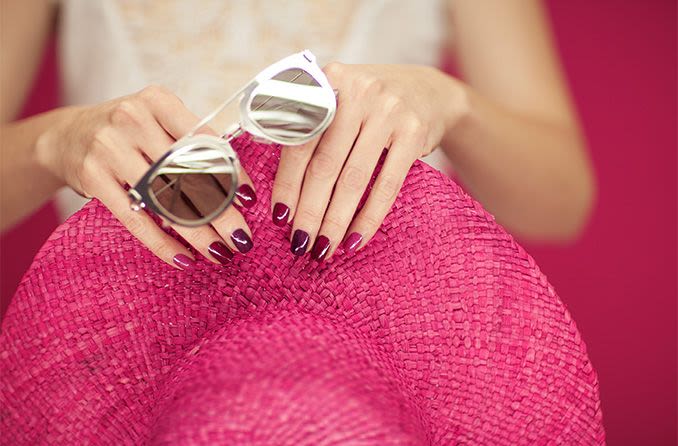Your guide to high-quality sunglasses

When it comes to investing in high-quality sunglasses, don’t let the designer label or dollar sign make your decision. You need to take a few other things into consideration.
For example, make sure those cool new shades offer UV protection. You’ll also want to choose durable frame materials, and be sure your sunglasses provide adequate coverage to protect your eyes and the sensitive skin around them.
Our guide details the factors to consider when shopping for high-quality sunglasses:
How important is UV protection?
Don’t let the lens shade fool you — UV-blocking capability and lens darkness are not one and the same. In fact, UV protection is dependent on whether or not certain chemicals have been applied to the lenses during manufacturing, not the lens color or depth of tint.
To ensure your eyes are protected, always look for sunglasses that are labeled as blocking 99% or 100% of UV rays. Some labels will also say “UV absorption up to 400nm” or UV400, which is equivalent to 100 percent protection.
Shielding your eyes from the harmful effects of UV exposure should be your No. 1 priority when picking out high-quality sunglasses.
What sunglasses frame materials are best?
While you’re shopping for the shape and style of your prospective shades, consider whether the frames are durable enough for your lifestyle.
The American Academy of Ophthalmology recommends inspecting sunglass frames for weight, strength, flexibility and resistance to corrosion and impact. You’ll find a variety of frame materials out there, ranging from metals, including monel and titanium, to plastics like zyl and nylon.
Metal frames are a popular choice due to their malleability and corrosion resistance. However, metal frames won’t offer as many style and color choices as plastic frames.
Plastic frames are generally cheaper and feature an endless array of color and pattern options, but some are also easier to break. Extreme sunlight exposure can also diminish their strength and color over time.
Each frame material comes with unique benefits and drawbacks, so ask an eyewear professional for advice about the best option for you.
What sunglasses lens materials are strongest?
Both glass and plastic lenses have their pros and cons, so it’s up to you and your eyewear provider to make the right choice.
Glass lenses are typically more resistant to scratches and offer the clearest vision. Glass tends to be heavier, though, so your frame options and tinting capabilities may be a bit limited. Glass lenses also are not as impact-resistant as plastic lenses and could pose a very real danger to children (and clumsy adults).
Plastic lenses are more lightweight and cheaper than glass lenses, which is why the vast majority of plano (non-prescription) sunglasses and clip-on sunglass lenses are made of this inexpensive-yet-durable material. Plastic lenses also easily allow for additional coatings to keep your vision crisp and comfortable.
No matter which lens material you choose, sunglass lenses should be inspected for color matching and UV absorption and be free of any distortion and imperfections to ensure optimum clarity and protection.
Which lens coatings should I consider?
Lens add-ons like polarization, gradients and anti-reflective (AR) coatings won’t contribute to UV protection, but lens coatings can further keep your eyes comfortable and your shades lookin’ sharp.
For example, if you participate in high-glare activities like skiing or fishing, you may want to consider polarized lenses. This specialized lens coating typically isn’t super expensive, and it will help eliminate glare and prevent eye strain.
Mirrored coatings, as well as gradient and double-gradient lenses, also are a great option for high-glare activities. Not only will they add a layer of glare defense, but they’ll also add a layer of cool to your new sunglasses.
If you are shopping for prescription sunglasses, you might also consider photochromic lenses, such as Transitions, for a little two-in-one convenience. Photochromic lenses automatically darken in bright sunlight and lighten in low light, meaning you only have to buy one pair of glasses for indoor and outdoor wear.
Regardless of your lens material and coatings, your lenses should be dark enough to screen out 75% to 90% of visible light, the Glaucoma Research Foundation says.
Pro tip: If you can see your eyes clearly through the lenses when you look in the mirror, they’re probably not dark enough.
Do my sunglasses offer enough sun protection?
Your sunglasses may block 100% of ultraviolet rays, but do they cover enough of your eyes to protect them from sunlight shining in all directions?
Those tiny round or funky lightning bolt frames may look supremely hip, but eyes need protection from more than just sunshine directly ahead.
To ensure you’re getting the most from your shades, look for large or wraparound styles for true sun protection.
Wraparound sunglasses cover from temple to temple and prevent harmful rays from entering through the sides, keeping your eyes and that extra sensitive skin surrounding your eyes shielded from the sun.
RELATED READING: Everything you need to know about sunglasses
Page published on Sunday, February 9, 2020




